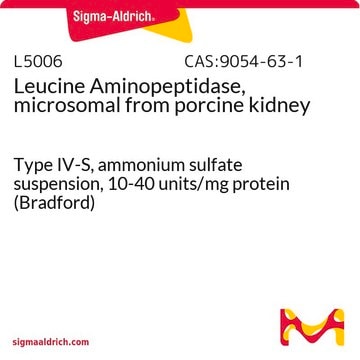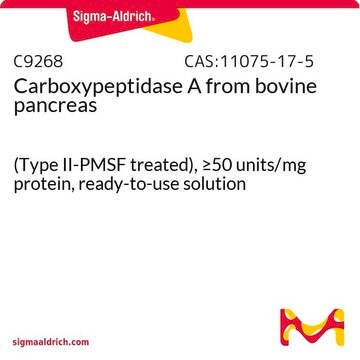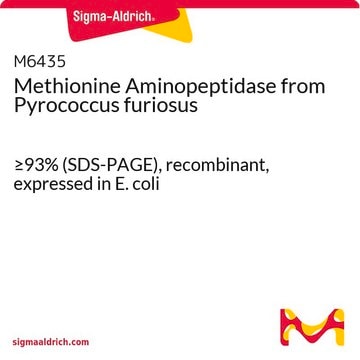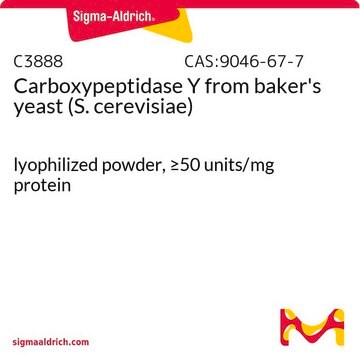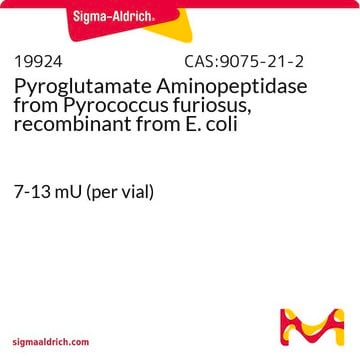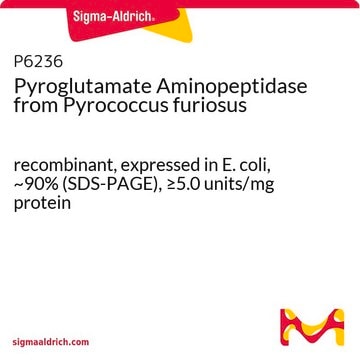A9934
Aminopeptidase I from Streptomyces griseus
lyophilized powder, ≥200 units/mg protein
Synonym(s):
Leucine Aminopeptidase IV
Sign Into View Organizational & Contract Pricing
All Photos(1)
About This Item
Recommended Products
form
lyophilized powder
Quality Level
specific activity
≥200 units/mg protein
mol wt
21 kDa by gel filtration
33 kDa by SDS-PAGE
composition
Protein, 40-60% Lowry
storage temp.
−20°C
General description
Aminopeptidase I from Streptomyces griseus is a thermostable enzyme with Glu131 and Tyr246 as key active site residues.
Application
Aminopeptidase I from Streptomyces griseus has been used:
- to test the biochar exposure effect on the enzyme activity
- in circular dichroism (CD) spectroscopy studies
- as a positive control in p-nitroanilide degradation assay
Biochem/physiol Actions
Aminopeptidase I from S. griseus has a fairly broad specificity, being able to remove the N-terminal residue of most proteins, except where the penultimate residue is an imino acid. It contains two Zn2+ binding sites. Aminopeptidase I from S. griseus is inhibited by 1,10-phenanthroline and is activated six-fold by Ca2+, which also stabilizes it against heat inactivation. This monomeric zinc metalloprotein has an isoelectric point (pI) of 5.4.
Aminopeptidase I may also be used as a reagent in the assay of endoprotease activities with a synthetic substrate in a two-stage assay. In the first stage, the endoprotease cleaves a peptide, such as Z-Y-X-Leu-p-nitroanilide, with the X, Y, and Z residues being chosen according to the specificity of the endoprotease.
Packaging
Package size based on protein content.
Unit Definition
One unit will hydrolyze 1.0 μmole of L-leucine-p-nitroanilide to L-leucine and p-nitroaniline per min at pH 8.0, 25 °C and 3.0 mM substrate concentration.
Physical form
Contains calcium acetate
Preparation Note
Reconstitute in 20 mM tricine, pH 8.0, with 0.05% bovine serum albumin. Dilute the enzyme with the reconstitution buffer to 0.15-0.3 U/mL for a working concentration. Solutions should be prepared fresh prior to use.
Other Notes
Endopeptidase contaminant: Not more than: 0.01 U/mg protein (as μmole tyrosine equivalent per min released from casein.)
Signal Word
Danger
Hazard Statements
Precautionary Statements
Hazard Classifications
Eye Irrit. 2 - Resp. Sens. 1 - Skin Irrit. 2 - STOT SE 3
Target Organs
Respiratory system
Storage Class Code
11 - Combustible Solids
WGK
WGK 1
Flash Point(F)
Not applicable
Flash Point(C)
Not applicable
Personal Protective Equipment
dust mask type N95 (US), Eyeshields, Gloves
Certificates of Analysis (COA)
Search for Certificates of Analysis (COA) by entering the products Lot/Batch Number. Lot and Batch Numbers can be found on a product’s label following the words ‘Lot’ or ‘Batch’.
Already Own This Product?
Find documentation for the products that you have recently purchased in the Document Library.
Customers Also Viewed
Jason L Parsons et al.
The FEBS journal, 272(22), 5753-5763 (2005-11-11)
Ionizing radiation, oxidative stress and endogenous DNA-damage processing can result in a variety of single-strand breaks with modified 5' and/or 3' ends. These are thought to be one of the most persistent forms of DNA damage and may threaten cell
Wakana Adachi et al.
Acta crystallographica. Section F, Structural biology and crystallization communications, 63(Pt 3), 200-203 (2007-03-03)
The vacuole hydrolase aminopeptidase 1 (Ape1) is a cargo protein transported to the vacuole by the cytosol-to-vacuole targeting (Cvt) pathway during conditions of growth and by autophagy during conditions of starvation. After transport to the vacuole, Ape1 is processed into
[Cytoplasm to vacuole targeting pathway in yeast].
Takahiro Shintani
Tanpakushitsu kakusan koso. Protein, nucleic acid, enzyme, 51(10 Suppl), 1480-1483 (2006-08-23)
Bonnie K Baxter et al.
The Journal of biological chemistry, 280(47), 39067-39076 (2005-09-28)
The cytoplasm to vacuole (Cvt) trafficking pathway in S. cerevisiae is a constitutive biosynthetic pathway required for the transport of two vacuolar enzymes, aminopeptidase I (Ape1p) and alpha-mannosidase (Ams1p), to the vacuole. Ape1p and Ams1p bind to their receptor, Atg19p
Sobhan Sen et al.
Biophysical journal, 89(6), 4129-4138 (2005-10-04)
Synthetic oligonucleotides with a fluorescent coumarin group replacing a basepair have been used in recent time-resolved Stokes-shift experiments to measure DNA dynamics on the femtosecond to nanosecond timescales. Here, we show that the APE1 endonuclease cleaves such a modified oligonucleotide
Our team of scientists has experience in all areas of research including Life Science, Material Science, Chemical Synthesis, Chromatography, Analytical and many others.
Contact Technical Service

